Sep 30, 2020 | Anxiety, Fire
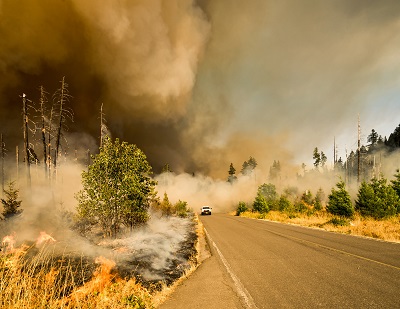 A muffled crack of thunder, followed by a flash of light that lit up the bedroom wall. Then another, louder CRACK! I had been lying in bed awake since 1AM, for three hours, my husband next to me, deep asleep. But now the wind was pushing violently against our windows, and I woke him up. I did not want to be experiencing this alone. We pulled the slider open and stepped out onto our bedroom deck, surveying western Sonoma County. Every thirty seconds another jagged bolt of lightning flashed somewhere on the horizon. In forty years of living in California we’d ever seen anything like this. There were the thunderstorms when we visited my mother-in-law in Florida. But here we were missing a crucial counterbalance to the lightning. Rain.
A muffled crack of thunder, followed by a flash of light that lit up the bedroom wall. Then another, louder CRACK! I had been lying in bed awake since 1AM, for three hours, my husband next to me, deep asleep. But now the wind was pushing violently against our windows, and I woke him up. I did not want to be experiencing this alone. We pulled the slider open and stepped out onto our bedroom deck, surveying western Sonoma County. Every thirty seconds another jagged bolt of lightning flashed somewhere on the horizon. In forty years of living in California we’d ever seen anything like this. There were the thunderstorms when we visited my mother-in-law in Florida. But here we were missing a crucial counterbalance to the lightning. Rain.
When the previous night news reports had warned about the possibility of dry lightning it hadn’t seem possible. But now it was more real than anyone would have predicted. Could every strike of lightning start a fire? In our dry, heavily forested landscape what would that mean? “This feels like the end of the world,” my husband said, “Let’s pack the car and get out of here while we can.”
Flashback
Almost three years earlier, in October 2017, we were awakened at 1 AM by a friend calling us to tell us we needed to get out of our home, now! The smell of smoke filled the room. The electricity was out. We frantically pulled on our clothes and within five minutes we were in our car, inching our way through the smoke towards safety. An hour later our home and everything we owned was gone.
Much of the same emotions I felt at that time were here again, telling me to flee. But I knew something was different this time. Now, in our rebuilt home, standing in virtually the same spot in our bedroom, I recognized danger. But unlike the threat of three years before, this threat was not imminent. “Yes, let’s pack the car,” I said, “But I’m not going anywhere just yet.”
Safety and Security Shattered
Over the next 72 hours, the lightning strikes started hundreds of fires in California, Oregon and Washington, some that are still burning. As I write this newsletter, a new fire is raging only five miles from my home. The smoke from these fires is fouling the air, affecting millions of people hundreds of miles away. This at the same time we are suffering the worst pandemic in a hundred years, an economy threatening to slip into a depression, and the worst political and social unrest in decades.
What Should We Do?
As a CBT therapist working with clients who think their world is falling apart, and as a human being who has similar thoughts myself, I know that our natural instinct is to take action. Whether it is fighting or taking flight, or even freezing in place, our first reaction to the threat of loss is usually emotional reaction. We’re hard-wired this way. This leads to behaviors, like my husband wanting to jump in the car and get away. The problem with taking action when we are upset, is that it is unlikely to be wise action. The storm that morning was passing over us, casting bolts of lightning in every direction. Some of them could start fires, but which ones we’d have no way of knowing. Imagine my husband and I driving around Northern California, each time there was a strike of lightning ahead, turning the car around and driving a different direction. Imagine hundreds of thousands of other cars doing the same thing.
With an imminent threat, like a smoke-filled bedroom, our emotions are well equipped to guide us. But most of the threats we face today, though real, are not imminent, and thus, require wise action. And to unlock our own innate wisdom, we need to be able to tolerate the fight-flight emotions telling us to Do something now!
The therapy I provide for my anxious clients is simply teaching them to relax and lean into fear. Unless it becomes clear that action is called for, just being, not doing, is how we free ourselves from the trap of chronic fight-flight reactions to our anxiety.
Emotion & Meditation
In a perfect storm of uncertainty that we are all living in today it is of some comfort to me to know that spiritual masters agree. Pema Chodron, a Buddhist nun, has written extensively on how to find peace amid crisis. She says we must stay with our broken heart, our fear, our anger and outrage, that only by sticking with uncertainty do we learn to relax in the middle of chaos. This is the essence of mindfulness meditation—to place our attention on the thoughts, feelings, and emotions that are disturbing us in the moment, without attachment, judgment, storytelling, or problem-solving.
Many of us are familiar with the exercise of watching our thoughts without attachment, but it is often more difficult for us to do the same with our feelings. To curb our urges to resist and/or control our negative emotions, we must learn to experience the sensation of emotions in a grounded way, dropping our awareness out of our heads and into our bodies. The simplest path is to use our breath to open, surrender, allowing our muscles to soften, making space for our emotions to metabolize. Only when we can relax amidst the chaos of our emotions, can we conceive what is wise action.
Wise Action
The morning of the lightning storm, we packed our car with emergency supplies, water, tent, sleeping bags, and food. But we didn’t drive off looking for a safe place. We went for a silent hike in a wooded area that had burned the year before. In the distance we could see the storm continuing, but we could also see new growth coming back and many of the old oaks had survived. Nature has a way of healing itself. We too have a natural ability to heal ourselves. And I believe, that collectively, we will be able to heal from the crisis that we face—from fires, from the pandemic, from the political polarization and social injustice, to whatever we face in the future. The first step is for each of us to move from a fight-flight reaction to wise action.
Meditation for Emotion
By opening up to painful emotions, we are learning to relax into discomfort itself. This meditation will help you to be here for yourself, no matter what you are feeling. You can listen to this meditation by clicking here.
This article first appeared on the website of the Anxiety and Depression Association of America.
Nov 15, 2018 | Fire
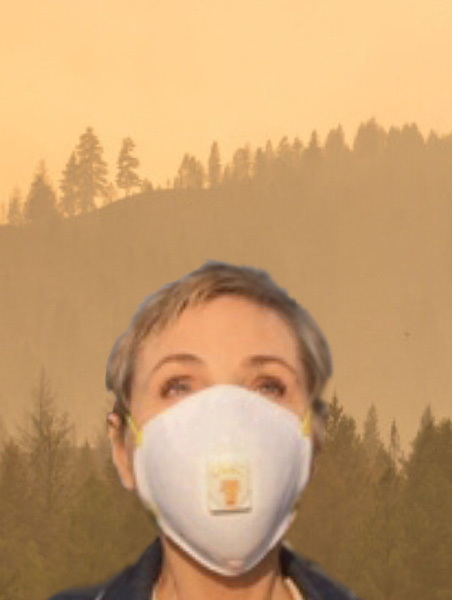
We are hearing a lot about how to stay physically healthy with our skies covered with dangerous levels of smoke in the air. Stay indoors as much as possible, Outside, wear a N95 rated face mask and avoid strenuous exercise. Set your car cooling and heating system to recirculate. But how do we take care of our mental health when we are faced with real danger?
HINT: Do not leave this job up to your monkey mind!
To the survival-oriented security guard residing in our unconscious, nothing less than 100% safety will do. Left unchecked, the monkey mind will continue to barrage us with negative emotion until the threat posed by air pollution is completely eliminated. In our highly emotional state we feel compelled to act.
We monitor news feeds about fire containment now.
We check to see what the air quality is now.
We research air purifiers, compare masks vs. respirators, and study long term health risks.
We worry about what the air may be doing to our health and the health of our loved ones.
We look at real estate outside of California.
The 90/10 Rule
If we leave ourselves unchecked, we will be spending 90% of our time attempting to eliminate the risk of breathing tainted air—allowing the monkey mind to run the show—and 10% of our time doing restful and restorative activities that foster mental health.
When under physical stress, we need to do just the opposite. That means spending 10% of our time taking reasonable precautions, and 90% of our time learning to relax in the face of danger and uncertainty. Here are three suggestions how to tame the monkey and manage that reversal.
1. Limit time on checking and researching. This might mean checking news feeds just once in the morning and once in the evening. If you are researching air purifiers, set the timer for 30 minutes and once it goes off, either make the decision then, or put off more research until tomorrow.
2. Notice when you are acting with the monkey mindset: I cannot rest or relax until I have eliminated the threat posed by air pollution. Remind yourself of the new “expansive” mindset you want to cultivate instead: I can take reasonable precautions that can limit risk, but it is just as important to learn to relax into uncertainty, which fosters resilience to whatever happens in life.
3. Listen to a welcoming anxiety practice I made specifically for this air quality crisis. Learning to welcome anxiety, rather than reacting to it, not only fosters a more peaceful state of mind, it calms down the nervous system, a key to emotional health.
My last suggestion is to try to have some fun. What restful or restorative activity can you do, given the restrictions of the situation? My daughter calls it taking a “smoky snow day”. Share your ideas and/or experience by posting a comment!
Dec 6, 2017 | Fire

The link below is for an op-ed article I wrote that was published in the Santa Rosa Press Democrat on December 3, 2017. Please share it far and wide, particularly with anyone you know who was touched by the fires, loves people touched by the fires, or is a compassionate helping professional who is caring for or treating someone who was touched by the fires.
http://www.pressdemocrat.com/opinion/closetohome/7711540-181/close-to-home-still-feeling
Nov 22, 2017 | Fire
by Jennifer Shannon, LMFT
The population of Santa Rosa is 175,000. While I love where I live and it has always felt like home, I can’t say that I’ve felt a strong sense of community. That has changed dramatically since the Tubbs fire that destroyed 3,000 homes, including mine, and caused the evacuation of thousands more.
Yesterday I got together with my friend Katherine for lunch in Healdsburg. She lives on Mark West Springs road, which was hit hard, and during the evacuation we texted back and forth about Mojo, our Jack Russell terrier that was missing and her horses and cats, which she had to leave behind. Although we were glad we had escaped with our lives, the possible loss of our beloved animals was agonizing. Fortunately, as it turned out, they all survived.
About 45 minutes into our lunch, sharing stories and tears, Katherine asked me how Mojo was found. “Mojo?” said our waitress who was refilling our glasses of water. “The little terrier lost in the fire? I’m the one who found him!”

Danae shows me a picture of Mojo from the day she saved him.
My jaw dropped. This was the young woman who, along with her boyfriend, met us in a Raley’s Parking lot to deliver our dog. But I was in shock at the time, and hyper focused on Mojo, who sat shivering in the back seat of their car. I was grateful, but honestly did not remember them or their faces. Doug and I wanted to see them later, to thank them again, but were not sure how to get a hold of them.
Tears of gratefulness, surprise, and awe trickled down my face. We’d picked this restaurant, new to us, in a nearby town, and randomly been given this table with this waitress. Then Katherine asked about Mojo at the exact moment she came to refill our water glasses! When our waitress, who introduced herself as Danae, had a break she sat down with us and showed us picture on her phone of Mojo at the time of the rescue. Then she told us in detail how the rescue took place.
The day after the fire, Danae and her boyfriend, both dog owners themselves, happened to see Mojo running erratically through a chaotic scene of fire trucks, police and residents in the still smoldering Coffee Park area. He was obviously lost, and they ran after him. Danae said she’d never seen a dog run so fast, it didn’t look like his feet were touching the ground. They chased after him through the streets for nearly half an hour until finally, Mojo jumped into a swimming pool, filled with fire debris, logs and ash. When Danae saw him go under the water she instinctively jumped in after him. She was able to grab him and as she handed him up to her boyfriend, the dog, crazy with fear, bit him on the hand. Only after they read Mojo’s tag, and began calling him by his name was he able to calm down. He even began licking their hands. And then they called us.
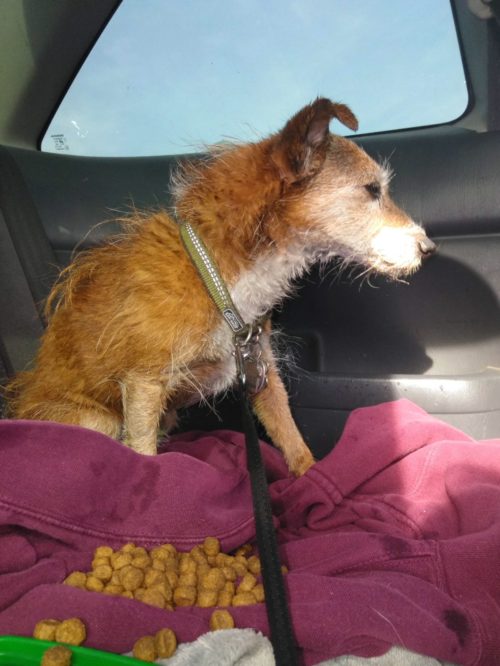
Mojo wet and tired in the backseat of Danae’s car after being rescued.
Later, as we were waiting for our check, Danae told us that a woman sitting at a nearby table overheard that I had lost my home and paid for our lunch. I went over to thank her, and I found out that she too lives in Santa Rosa, and that although it was touch and go, her house was saved. She said she is now renting out a small house on their property to a couple who had also lost their home in Fountaingrove. I asked who it was, and it turned out it was my neighbor from the condo next to ours!
That wonderful afternoon, with my friend, the woman who saved our dog, another woman who paid for our lunch and opened a home on her property to a neighbor who lost her home, I had a stronger sense of community and connection than I had ever had, not just in Santa Rosa, but in my life. This is something I am tremendously grateful for this Thanksgiving.
As a therapist and author who specializes in stress and anxiety, and has lost my home in the Santa Rosa fire, I am writing this blog to remind myself of the powerful tools I use in my practice with my clients. If It helps others to deal with their own challenges, nothing would please me more.
Nov 17, 2017 | Fire
by Jennifer Shannon, LMFT
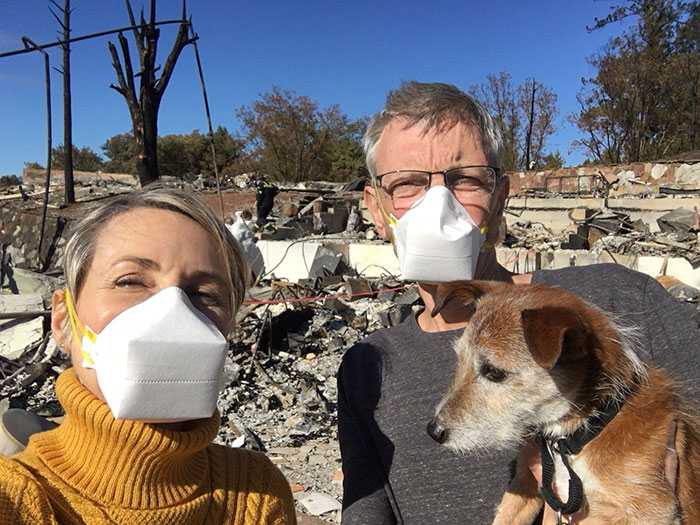
The remnants of our home. Me, Doug, and Mojo
Sunday evening, the night before the fire, Doug and I returned from a weekend away. When I walked into the house I said to Doug, “Home Sweet Home”. It felt good to be back. Ever since I was a child, home has been my favorite place on earth. I am an introvert, and so the solitude that I get from being at home recharges me. In addition to the solitude, my belongings gave me comfort. My bed and blankets, my couch, my soft carpet, my plants, and my cloths; the familiarity of my home was comforting. Knowing where everything was in the kitchen, a kinesthetic knowledge of the stairs, how my furniture was arranged, even in the dark I could navigate my home.
The fire destroyed all of that, so quickly, so thoroughly. While seeking shelter at my mother’s tiny studio at 3AM that morning, my mind was going to where would we stay? In my book, Don’t Feed the Monkey Mind, I talk about how all fear and anxiety comes down to 2 core fears. Number one is the loss of life, loved ones, health or food and shelter. I was already incredibly grateful that Doug and I were alive, but I did lose my shelter. I impatiently waited until a decent hour to text a friend of mine who I knew had a spare room, to ask if we could stay there. She texted back immediately saying “Of course”. Ahhhhh.
We stayed with my friend for a month. Her home is out in rural Occidental, and the quiet of nature soothed my disquieted soul. I was so grateful to have a warm bed to crawl into each night. But I did not have the solitude I was used to while living in someone else’s home. I did not have my things, and I did not have familiarity with where things were.
We started looking for a long-term rental. This has been one of the most stressful things I have had to do since the fire. The rental market in Sonoma county is very tight, and with 3,000 people losing their homes, I knew that it would be even tighter. My monkey mind was going wild, what if we don’t find something, what if we must settle for a place that I won’t ever feel comfortable in? So, I drew on my community. I asked everyone I know, from the ladies in the locker room at the gym to my friends and acquaintances to keep their eyes open. I was able to escape the cutthroat completion for housing that I feared. My community came through for me. An acquaintance from my Toastmasters Club offered her Airbnb for us to stay at while we rebuild our home.
Moving to a new place is pretty easy when you have nothing to move into it. The home is already furnished, so we don’t have to shop for all new household items. Now it is time to nest. I have the solitude back, which feels amazingly wonderful. I feel tentative with the things in the house, as I don’t own them, and I am getting used to the layout of the house and the land. This morning at dawn, I took a walk around the perimeter of the property, saw an owl hunting for food, the sun rising, the fog and the clouds. Nature, in all her glory has always been here for me, this I can return to over and over, no matter where I am.

The property around our new rental home.
As a therapist and author who specializes in stress and anxiety, and has lost my home in the Santa Rosa fire, I am writing this blog to remind myself of the powerful tools I use in my practice with my clients. If It helps others to deal with their own challenges, nothing would please me more.
Nov 14, 2017 | Fire
by Jennifer Shannon LMFT, with Doug Shannon
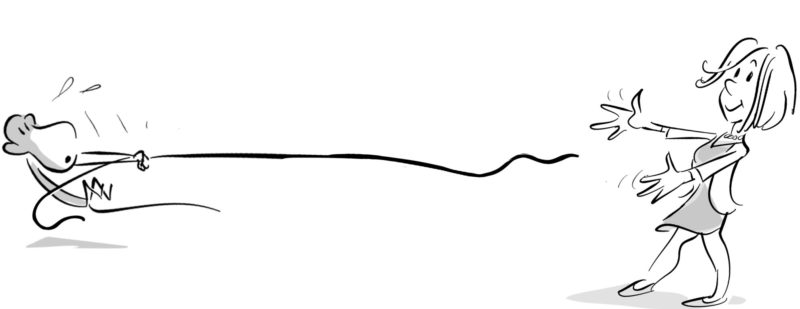
I started back to Toastmasters this week. It starts at 7am and I like to be on time, but I am staying temporarily with a friend way out in the country, and getting to town takes a long time. After packing up all the things I’d need for a long day at work, I ended up leaving 10 minutes later than planned. As I turned the ignition my mind started racing, grasping for a way to control the situation. How late will I be? What route is the fastest? Then I remembered something I’d heard Tara Brach, a terrific Buddhist teacher, say in a podcast.
Let go a little and you get a little peace
Let go a lot and you get a lot of peace
Let go totally and you get total peace
“Letting go” is not in my nature. I like to be in control. But then again, I do want peace. I decided to let go of the possibility of arriving on time. I took my normal route and drove at my normal speed. I did not look at the clock.
But I did not feel instant peace. Being out of control felt more painful than trying to stay in control. My chest felt tight as I instructed myself to breath into it. But with each mile I felt a little more relaxed. It wasn’t peace exactly, but I knew that I was investing toward more peaceful commutes in the future.
A bigger letting go challenge has been around housing. After losing our home to the fire, finding a home in a very competitive and scarce rental market has been difficult. We found a place I thought I could love and I did everything I could to secure it. I met the current tenant, I reached out to the neighbor and I e-mailed the landlords repeatedly. If I could just nail the place down, I’d feel safe and secure. But when the landlords decided to hold an open house instead of committing to us, I had to let go.
We kept looking, and an acquaintance from my recently joined Toastmasters offered to rent us her Airbnb. It is month to month, and it is in a flood zone, but it is beautiful and fully furnished. We decided to sign the lease. Of course, my monkey mind went wild trying to make certain it’s the right decision, revisiting the pros and cons. Is the space big enough? Did we look in enough places? Will we get flooded out? Woo-woo-woo! I want control, but I also want peace, and I can’t have it both ways.
For now anyway, I do feel a little peace. And I know that in the future, there will be a lot more opportunities for me to let go, and that will bring a lot more opportunities for peace.
As a therapist and author who specializes in stress and anxiety, and has lost my home in the Santa Rosa fire, I am writing this blog to remind myself of the powerful tools I use in my practice with my clients. If It helps others to deal with their own challenges, nothing would please me more.
 A muffled crack of thunder, followed by a flash of light that lit up the bedroom wall. Then another, louder CRACK! I had been lying in bed awake since 1AM, for three hours, my husband next to me, deep asleep. But now the wind was pushing violently against our windows, and I woke him up. I did not want to be experiencing this alone. We pulled the slider open and stepped out onto our bedroom deck, surveying western Sonoma County. Every thirty seconds another jagged bolt of lightning flashed somewhere on the horizon. In forty years of living in California we’d ever seen anything like this. There were the thunderstorms when we visited my mother-in-law in Florida. But here we were missing a crucial counterbalance to the lightning. Rain.
A muffled crack of thunder, followed by a flash of light that lit up the bedroom wall. Then another, louder CRACK! I had been lying in bed awake since 1AM, for three hours, my husband next to me, deep asleep. But now the wind was pushing violently against our windows, and I woke him up. I did not want to be experiencing this alone. We pulled the slider open and stepped out onto our bedroom deck, surveying western Sonoma County. Every thirty seconds another jagged bolt of lightning flashed somewhere on the horizon. In forty years of living in California we’d ever seen anything like this. There were the thunderstorms when we visited my mother-in-law in Florida. But here we were missing a crucial counterbalance to the lightning. Rain.








Recent Comments